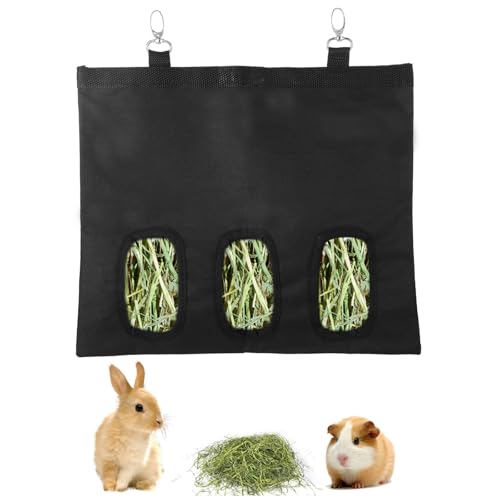Thank you that is very helpful.
You are using an out of date browser. It may not display this or other websites correctly.
You should upgrade or use an alternative browser.
You should upgrade or use an alternative browser.
Talk to me about Comfrey
- Thread starter alforddm
- Start date

Help Support Rabbit Talk Forum:
This site may earn a commission from merchant affiliate
links, including eBay, Amazon, and others.
From
TOXIC WEEDS IN HAY AND THE EFFECTS ON LIVESTOCK
Birgit Puschner
And the source referenced for that:
That also helps explain why dried Coltsfoot, Tussilago Farfara (another Pyrrolizidine alkaloid containing plant) can be found for sale as a small animal treat in the UK.
http://burnspet.co.uk/products/small-an ... sfoot.html
https://www.thehayexperts.co.uk/coltsfoot.html
As far as animals naturally avoiding plants that contain those...
Both young Comfrey leaves and Coltsfoot leaves of any age are favorite treats here. Maybe these two plants do not contain enough for rabbits to be worried about?
I wouldn't feed the roots of either plant, as I've read that larger concentrations of the alkaloids are found in the roots than the leaves.
(looking for a source)
TOXIC WEEDS IN HAY AND THE EFFECTS ON LIVESTOCK
Birgit Puschner
Pyrrolizidine alkaloids: Plants containing pyrrolizidine alkaloids (PAs) are found throughout the
world. PA poisoning is of great economic importance as a cause of progressive liver disease in
livestock, wildlife and humans. The disease has been reported from most areas of North America
and is mostly caused by plants from the genus Senecio, but other plant genera such as Amsinckia,
Cynoglossum, Echium and Heliotropium also contain the toxic alkaloids. Within the Senecio
genus, Senecio vulgaris (common groundsel) and Senecio jacobaea (tansy ragwort) are common
weeds in hayfields in California and are also widely distributed along the East Coast and Canada.
PA-containing plants are usually unpalatable and animals avoid them. However, animals are
often not able to differentiate the toxic weeds in hay and ingest the toxic alkaloids. PAs are
hepatotoxic, causing irreversible liver damage (Cheeke, 1998). Horses and cattle are the major
livestock species poisoned by PAs. Sheep, goats and small herbivores (e.g. rabbits, guinea pigs,
hamsters) are resistant to PA toxicity due to detoxification processes in the liver (Cheeke, 1994).
PA poisoning is usually a chronic disease and clinical signs may not appear for 2-8 months after
the first ingestion of the toxic plants. Affected animals lose condition, and develop icterus. Cattle
may also develop photosensitization. Neurological signs are commonly seen in horses, and the
And the source referenced for that:
Cheeke PR: 1994, A review of the functional and evolutionary roles of the liver in the
detoxification of poisonous plants, with special reference to pyrrolizidine alkaloids. Vet Hum
Toxicol 36:240-247.
That also helps explain why dried Coltsfoot, Tussilago Farfara (another Pyrrolizidine alkaloid containing plant) can be found for sale as a small animal treat in the UK.
http://burnspet.co.uk/products/small-an ... sfoot.html
https://www.thehayexperts.co.uk/coltsfoot.html
As far as animals naturally avoiding plants that contain those...
Both young Comfrey leaves and Coltsfoot leaves of any age are favorite treats here. Maybe these two plants do not contain enough for rabbits to be worried about?
I wouldn't feed the roots of either plant, as I've read that larger concentrations of the alkaloids are found in the roots than the leaves.
(looking for a source)
My rabbits don't like the comfrey roots , except a nibble here and there. - but will eat a lot of the leaf sometimes, but- if I feed a lot of it, they will avoid it after 2 or 3 days of eating a lot. Thats why it is important to feed a variety of feeds so they can choose the things they need and avoid things they have had enough of. When I feed Comfrey leaf, they also get kale, and weeds [lambsquarter, amaranth, and cheese weed, [malva neglecta] and grass hay. like I said above, up to 25% comfrey was no problem, but I still would not include it in a pelleted ration again [even if I could afford another pelletizer] - because I like the idea of them being able to choose what they eat.
the reluctant farmer":2yg9msit said:In the area I grew up in it was regularly used by the Polish & Russian immigrants who had migrated there, and it rapidly spread from small homesteads to becoming invasive with the use of industrial tilling methods. My understanding was that it was used by the old settlers as a medicine by poultice or through tea/tonic and also as an animal food. I'd suspect that either the toxicity reports come from large amounts or if it is eaten in isolation. Possibly they were eating other things alongside it that balanced out any accumulation. I think Rainey's approach makes sense, and I intend to be feeding it this year since I have some plants my mom dug up and gifted me with. Will check out how my meat mutts do with it...
Toxicity reports mostly came from laboratory testing and were quite a surprise to the herb using community, considering it's long medicinal history. I remember some controversy over their banning for medicinal sale in a few countries.
Although there have been some modern cases, mostly from people using it in extract form or taking in an abnormally large amount of tea over a period of time.
http://livertox.nih.gov/Comfrey.htm
Hepatotoxicity
Several cases of acute liver injury resembling sinusoidal obstruction syndrome due to oral comfrey have been published. The injury usually arises within 1 to 2 months of starting the comfrey product (either extract in tablet form or large amounts of comfrey tea)
I'm not sure humans have the same capability to deal with the alkaloids that sheep and small animals have....so I personally avoid the internal use of both comfrey and coltsfoot myself , and favor herbs that I just don't have to worry about. I would guess that onset of liver disease in situations of normal use would be far far too slow for early physicians to have ever connected to the herb.
Here's a bit regarding the controversy from a Canadian herb company I sometimes use for hard to find plants:
https://www.richters.com/show.cgi?page= ... mfrey.html
michaels4gardens":2hnnwgzi said:I still toss some in with the rest of the weeds and kale, -- but-- I do not keep track of how much they eat.-- I just let them eat what ever they want , and the next night before I feed,- I toss the rest to the chickens, and sheep [caution, -young sheep can choke on comfrey, it sticks to their tongue like velcro, and can block the airway ]alforddm":2hnnwgzi said:Do you still feed comfrey? So, according to your observations an amount up to 25% of the diet can be beneficial?michaels4gardens":2hnnwgzi said:I have done some research on feeding comfrey, -when more then 35% of the diet was comfrey, I began to see lighter spots on the livers, and slight yellowing of the liver,[at 8 week butchering] and the growing rabbits slowed down on growth rate. I fed 25% as a part of the ration for 3 years, and saw a good increase in growth rate over the litters that did not get it. I saw no problems with the breed stock at all [but did not kill any of them to look] the greatest advantage was when the kits were still nursing, --it seems to me- does produce more milk when fed comfrey.
First -- I am not arguing or contradicting anything being said, [but just voicing my opinion ]- so-- JMHO -
I feel that until someone does testing on rabbits with actual feeding of the comfrey leaf to the rabbits, ,-conclusions about feeding rabbits cannot be reached, - I would like to point to the totally incorrect info about feeding garlic and all allium family plants to rabbits, [it is commonly cited , that all parts are extremely toxic to rabbits ] based on some research where extracts were injected into the animals, or research on cats. I have fed it quite successfully to remedy protozoan parasites , and infections. -and found research where others have done the same [sited in other threads about feeding garlic ] - I have done my own research on the feeding of comfrey, and stated the findings of my testing. These are just my findings - so -JMHO- but I would suggest that feeding the raw leaf to rabbits in small [less then 25% of diet] amounts ,has been very useful for me. I would also suggest caution in feeding comfrey ,by suggesting that other "safe" feeds should be available to the rabbits, so that if they get enough they will not be starved into over-consumption . [the same goes for Amaranth, Lambsquarters [chenopodium album ] , Cheese weed,[ Malva neglecta] and fescue ,-all have substances that have been shown to cause "poisoning" from over consumption. But- I would suggest that all of these plants are quite safe in moderate amounts. -
- Lima beans , and tapioca plant [cassava root, and leaf] are listed as toxic also, and should be fed in sane amounts. When fed as a part of a diverse diet containing some "totally safe " feeds, it is very uncommon to see any problems from feeding any of these plants to rabbits , when they can choose not to eat certain plants. [ but if added to a pelleted ration all can be dangerous as they can not choose what to eat].
-- So -it is very "important" to stress that a very "important " part of animal husbandry is careful observation---
I found these blogs interesting:
http://riseandshinerabbitry.com/2011/10 ... r-rabbits/
http://riseandshinerabbitry.com/2013/08 ... gold-mine/
I just got my first young plant this past Spring, and I think it is finally thriving enough that I can harvest some leaves from it.
I will also be using it for myself in this form:
http://thehomesteadsurvival.com/comfrey ... ood-magic/
http://riseandshinerabbitry.com/2011/10 ... r-rabbits/
http://riseandshinerabbitry.com/2013/08 ... gold-mine/
I just got my first young plant this past Spring, and I think it is finally thriving enough that I can harvest some leaves from it.
I will also be using it for myself in this form:
http://thehomesteadsurvival.com/comfrey ... ood-magic/

$9.99 ($3.33 / Count)
Springtime 3pcs Rabbit Fur Headbands for Women Girls Unique Faux Furry Hair Headband Soft Luxury Headwear Warm Hair Accessories
Chunxia Accessories

$4.89
$19.95
The Paleo Diet Cookbook: More Than 150 Recipes for Paleo Breakfasts, Lunches, Dinners, Snacks, and Beverages
PLUTO FINDS

$20.40
$34.95
The Autoimmune Paleo Cookbook: An Allergen-Free Approach to Managing Chronic Illness (US Version)
white lilies

$21.00
$27.99
The Fast Metabolism Diet Cookbook: Eat Even More Food and Lose Even More Weight
BNG LIMITLESS INC

$9.99
The Lodge Cast Iron Cookbook: A Treasury of Timeless, Delicious Recipes
Amazon.com Services LLC

$14.71
$29.99
Fit Men Cook: 100+ Meal Prep Recipes for Men and Women―Always #HealthyAF, Never Boring
Amazon.com

$12.25
$24.00
Top Secret Restaurant Recipes: Creating Kitchen Clones from America's Favorite Restaurant Chains: A Cookbook
Essentialsmerchant
ottersatin
Well-known member
This is a very interesting thread!
I have been feeding small occasional amounts of Comfrey to my Rabbits
for just about as long as can remember having it. It seems to me that they
are very fond of the few [one or two] leaves I give them every now and then.
I believe that everything, if fed in moderation has it's place.
Every medication that WE take IS a POISON! This is why the amounts,
and length of time taking it/them is specified.
I have my Comfrey planted where I can keep it under control.
Left to it's own it can become a growers problem, it can spread very quickly.
Ottersatin. ldtimer:
ldtimer:
I have been feeding small occasional amounts of Comfrey to my Rabbits
for just about as long as can remember having it. It seems to me that they
are very fond of the few [one or two] leaves I give them every now and then.
I believe that everything, if fed in moderation has it's place.
Every medication that WE take IS a POISON! This is why the amounts,
and length of time taking it/them is specified.
I have my Comfrey planted where I can keep it under control.
Left to it's own it can become a growers problem, it can spread very quickly.
Ottersatin.
ottersatin":31eww9ps said:This is a very interesting thread!
I have been feeding small occasional amounts of Comfrey to my Rabbits
for just about as long as can remember having it. It seems to me that they
are very fond of the few [one or two] leaves I give them every now and then.
I believe that everything, if fed in moderation has it's place.
Every medication that WE take IS a POISON! This is why the amounts,
and length of time taking it/them is specified.
I have my Comfrey planted where I can keep it under control.
Left to it's own it can become a growers problem, it can spread very quickly.
Ottersatin.ldtimer:
We feed it to rabbits, mostly in spring, and to goats and chickens and sometimes pigs (some will eat it, some not)
But if you have plenty of room you can put some where it won't be into the gardens and then cut any extra to add to the compost piles or to use as mulch around plants. My gardener daughter believes using it as mulch has cut down on tomato disease this wet season and she also puts some in the potato planting holes,says it prevents scab. I don't have a scientific study--just our experience.
























